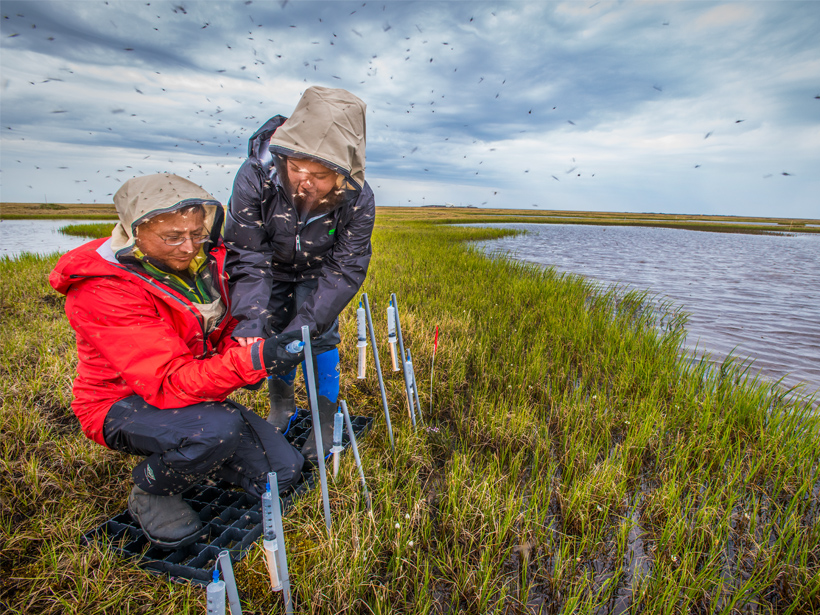Source: Global Biogeochemical Cycles
Roughly half of the world’s soil carbon is locked up in the frozen soils found at high latitudes, such as Arctic permafrost. However, rising temperatures are threatening to thaw out this frozen earth, hastening the decomposition of once-frigid organic matter and releasing the long-stored carbon into the atmosphere. Despite the profound effects that the freed carbon can have on global climate, the processes underlying the production and transport of methane and carbon dioxide in terrestrial Arctic ecosystems are not well understood, which makes it hard for scientists to predict what effect global warming will have on Arctic carbon stores in the future.
To provide some insight into these processes, Throckmorton et al. sampled 17 watershed drainage sites over a 2-month period, from stagnant wetlands to sluggish streams in the Arctic Coastal Plain in northern Alaska. According to the authors, such sites are a good proxy for the geochemical makeup of larger landscapes and can be a source of both methane and carbon dioxide greenhouse gases. The researchers measured the balance of isotopes in the samples to determine what processes are at play to produce and transport the carbon-based molecules and how those processes vary across time and soil depth. The team developed a novel isotope model to estimate microbial methane oxidation, which is the conversion of methane to carbon dioxide (a less potent greenhouse gas) in soils, prior to emission to the atmosphere.
The team was surprised to find that across the majority of sampling sites, the primary method of methane production was acetoclastic methanogenesis, a process that involves microbes converting organic acids to methane, as opposed to microbes converting inorganic carbon to methane. This is unexpected, as previous research often reported a lack of acetoclastic microorganisms in Arctic soils.
The authors write that the high moisture content and localized plant and microbial communities in drainages where samples were collected are likely promoting acetoclastic methane production. In fact, one of the dominant grassy plants in northern Alaska—Carex—has previously been shown to foster the production of methane via organic acids and is abundant in wetter localized areas. Another surprising finding was the extremely low methane oxidation in soils, consuming less than 3% of methane produced.
Carex plants could also be responsible for low methane oxidation by directly transporting methane to the atmosphere, bypassing oxidation conditions in the soil profile that are so important for consuming methane. Climate change–induced shifts in soil moisture and vegetation patterns, which influence the makeup of microbial communities, will likely alter mechanisms underlying methane production, oxidation, and emissions in the Arctic. The study provides new insights into methane production in Arctic soil and a model methodology for future studies of Arctic wetlands. (Global Biogeochemical Cycles, doi:10.1002/2014GB005044, 2015)
—Kate Wheeling, Freelance Writer
Citation: Wheeling, K. (2016), Tracking carbon in the Alaskan arctic, Eos, 97,doi:10.1029/2016EO045297. Published on 8 February 2016.
Text © 2016. The authors. CC BY-NC 3.0
Except where otherwise noted, images are subject to copyright. Any reuse without express permission from the copyright owner is prohibited.

